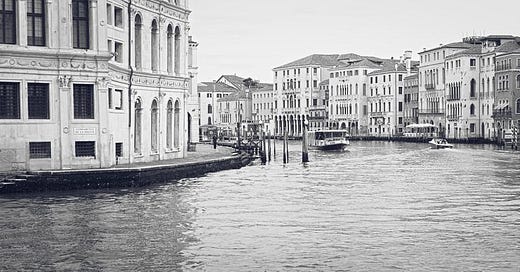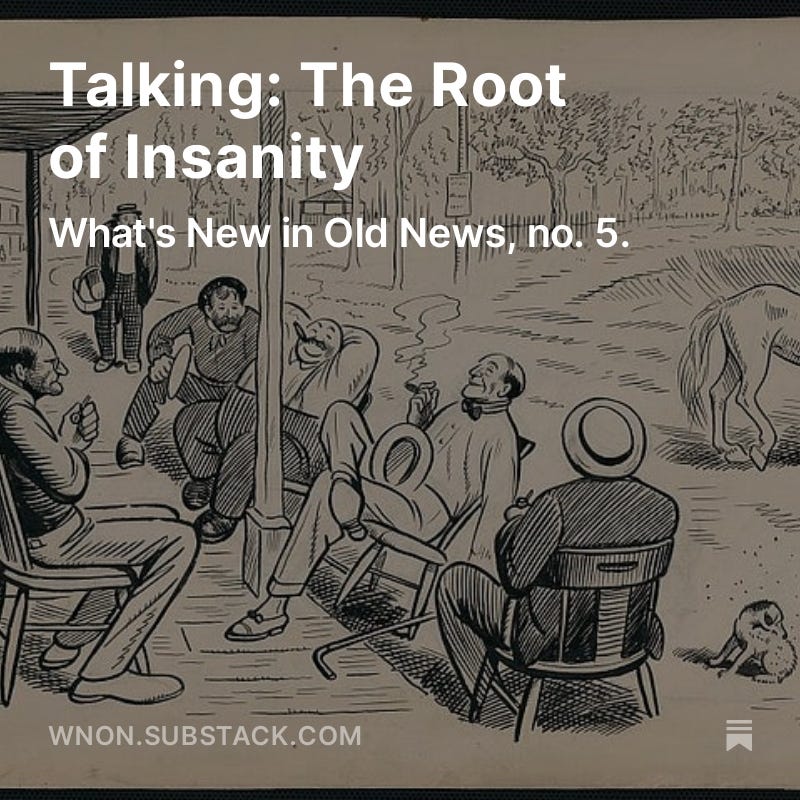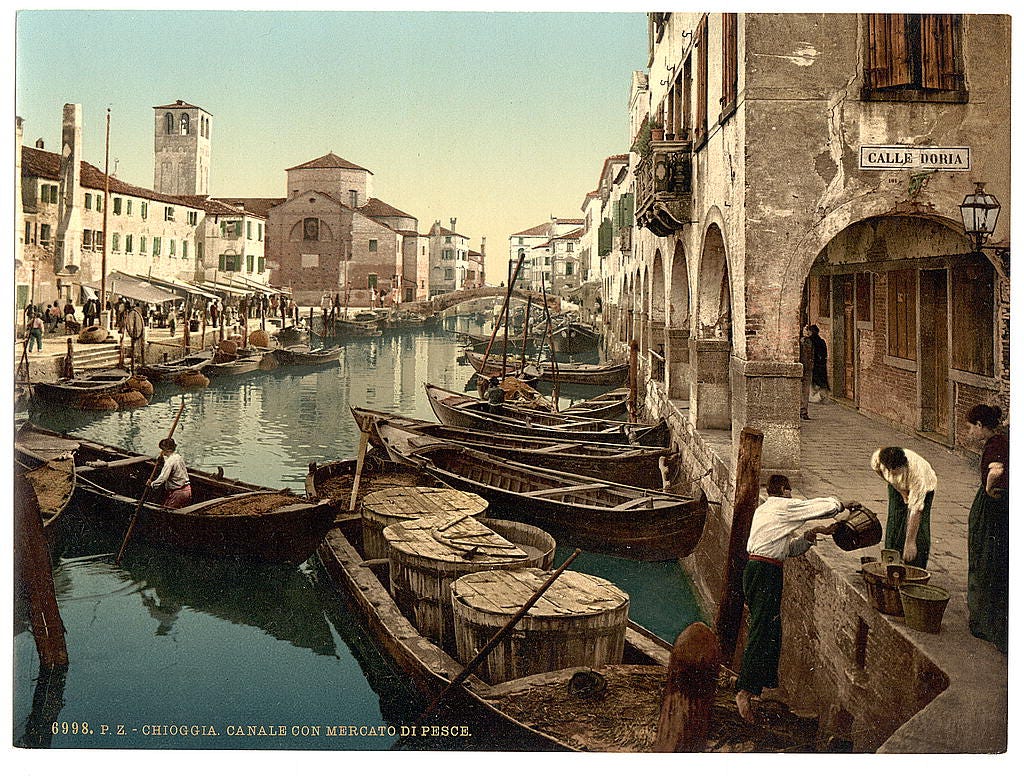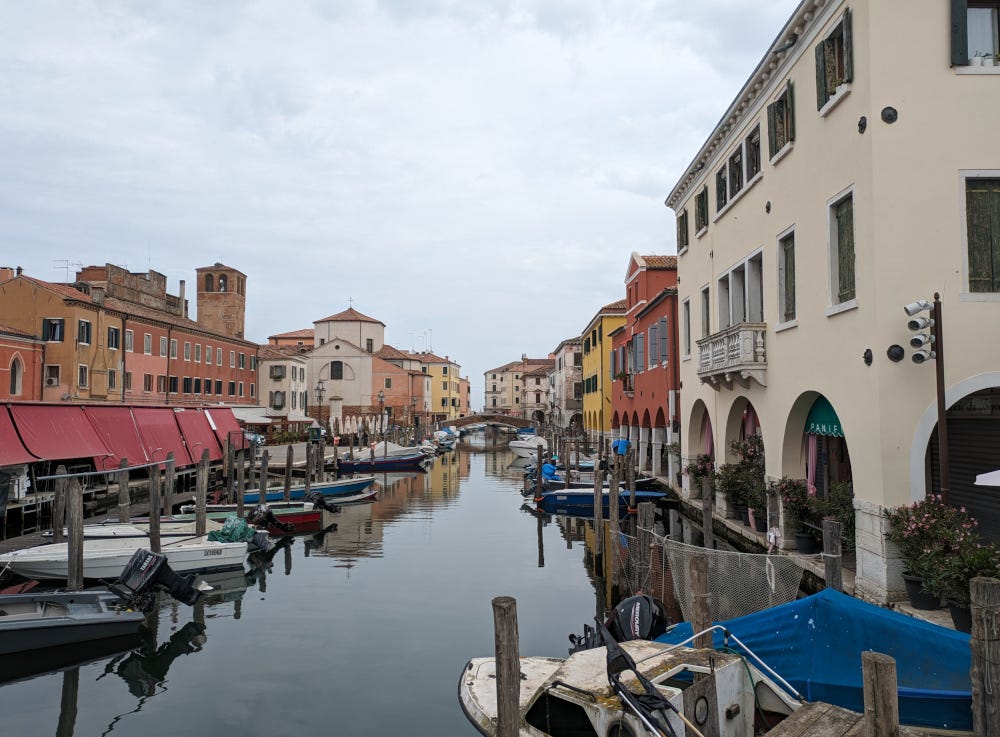Welcome to the June issue of the Peripatetic Historian.
This Month:
Peripatetic Field Report: Finding the 5% in Venice
Book News
What’s New in Old News?
Then and Now: Chioggia
Let’s get started…
Peripatetic Field Report: Finding the 5% in Venice
Henry James, the great American novelist, once proclaimed the futility of writing about Venice; it had all been said before—and probably better.
“There is notoriously nothing more to be said on the subject,” declared James in his Italian Hours. After the millions of words and equal number of paintings and photographs, all novelty had been drained from the topic. The world needed no more tributes to the finest city on the planet.
James offered only one exception to this rule: “I hold any writer sufficiently justified who is himself in love with his theme.”
Longtime readers of this monthly screed will be familiar with my obsession with La Serenissima. This is not the first time I’ve introduced the subject. And, of course, whenever I write “Venice” you must imagine the little catch in my voice, the wistful glimmer in my eyes.
Hemingway never shook Paris; James and I are Venice-enthralled.
Three events coincided in May to send me back to my spiritual homeland: the need to renew my Jordanian visa, a cheap fare on a budget airline, and the realization that an entire planet separates Taiwan (our next destination) from Italy. It may be a couple of years before I have another opportunity to return to the world’s greatest city.
We do crazier things with flimsier reasons. In the middle of May I left Jordan and flew to Venice for a two week fling.
What did I do? Basically the same things I do in Jordan—I wrote, worked on the research for my next book, took long walks. But I had transferred all of these activities to Venice, and that, as Mr. Frost said, made all the difference.
Having spent nearly a quarter of my life living outside of my home country (the United States) I have developed a theory about slow travel and expatriate life: 95% of any given day doesn’t change overseas. Existence brings universal tasks—working, eating, cooking, cleaning—and you will probably perform them in the same way you would at home.
But that 5%—well, that’s the cup that cradles the reason for living abroad.
This doesn’t apply if you are blitzing a destination as a tourist. In that scenario, you must cram as many sites into your day as you can. But when you remain in a place for an extended period of time—weeks, months, or years—the pressure comes off. The context rather than a checklist of tourist attractions becomes your focus.
I never go to Venice for less than a week. If you laid all of my trips end to end, I’ve probably spent three months in the city over the past twenty years.
That’s another way of saying I’ve been very fortunate.
As I was in this trip. I visited a couple of points on the tourist route—Torcello, the first island colonized by the Venetians; the Accademia Gallery to revisit the paintings of the masters—but for the most part I went my own way. I took long walks with my camera, practiced my Italian, and ate plates of my favorite Venetian dish: Sarde in Saor—sardines and onions.
But mostly, I simply opened my heart and soaked up the blessed 5%.
Book News
Save Some Money on L. A. Birdmen
Rowman & Littlefield, publisher of L.A. Birdmen, is offering newsletter subscribers 20% off the purchase price. If that’s something that might interest you, click this link and claim your discount:
The Birdmen Tour
For those of you living in the Pacific Northwest, I will be offering my new lecture— Lighter-than-Air: West Coast Pilots and the Dawn of Flight—at select venues. The tour schedule lives here:
What You Missed from What’s New in Old News?
The tectonic shift of last month’s rebranding is now behind us. As you will recall, this newsletter received a new name to better reflect its content and aspirations; at the same time I launched a new, weekly newsletter, What’s New in Old News?
I published five installments in the new series in May. Here are a couple of my favorites:
A deadly viper, a miraculous elixir that could cure the world’s diseases. What could go wrong?
Is excessive speech the root cause of insanity? Find out here:
Agriculture meets drama atop a New York theater:
And so much more.
What’s New in Old News? is published every Thursday. Each week offers a quirky bit of history that you are unlikely to find in a textbook. Intrigued? Why not sign up for your free subscription today?
Then and Now
As an old Venice hand, I’ve visited most of the popular sites—both in and out of the city. One spot eluded me. At the southern end of the lagoon, where the water narrows to wash the mainland, is the small town of Chioggia. Every picture I saw seemed to suggest that Chioggia was a little Venice—canals, churches, brick and marble architecture. My kind of place. Nevertheless, I had never made it down there.
That all changed this month.
The first thing to note is that Chioggia is a bit out of the way. From Venice you must hop a vaporetto (water bus) heading to the Lido. There, at the station Lido S. M. E. (Santa Maria Elisabetta) you board an electric bus (number 11) and glide southwest toward Pellestrina. Before you arrive, the bus rolls aboard a car ferry, which whisks you across an inlet dividing the Lido. Back on dry sand at Santa Maria del Mare the bus continues south and ultimately reaches Pellestrina.
Off the bus, on to a second vaporetto for the last leg of the journey, a twenty minute voyage to Chioggia.
It’s a lengthy trip—about two hours and thirty minutes—but ultimately very rewarding. Chioggia exceeded my expectations. Long canals penetrate the town center; eroded stone bridges spare pedestrians the indignity of wading. I saw no gondolas, but Chioggia does have bicycle, motor scooter, and automobile traffic along the canals. Car-free Venice had lulled me into a sense of complacency, and I had several near misses with wheeled traffic.
Also charming were the porticos, long arched galleries lining the canals and side-streets. It reminded me of Bologna, another town blessed with this most pleasing architectural feature.
Unlike Venice, which is sustained by tourists, Chioggia is a real fishing town. The canals were filled with boats of sizes, from skiffs to massive commercial craft. Fishing links Chioggia to its past, as this picture from 1898 suggests:
In this image, the fish market is seen in the distance, on the left side of the canal. The market remains today (the red awnings), handling the catch as it arrives.
I had hoped to get a cleaner shot of the portico, to the right, over the Calle Doria, but a large fruit stand occupies the spot where I would need to stand to match the shot perfectly.
In any event, apart from the modern fiberglass boats, a touch of paint, and a change of awnings, this superb town remains largely unchanged and highly recommended.
Our sojourn in Jordan has dwindled to a matter of days. Fifteen, to be precise.
We will be touching down in Taipei in August. A short visit to the United States will interrupt our departure from Jordan and our Asian arrival. As always, I’ll keep you apprised of the peripatetications in the next installment of the newsletter.
Until then, be safe, be sensible,












Indeed. My favorite dish in Venice
0600 vs 1800. But if I had to spend a night roaming any city, it would be Venice.